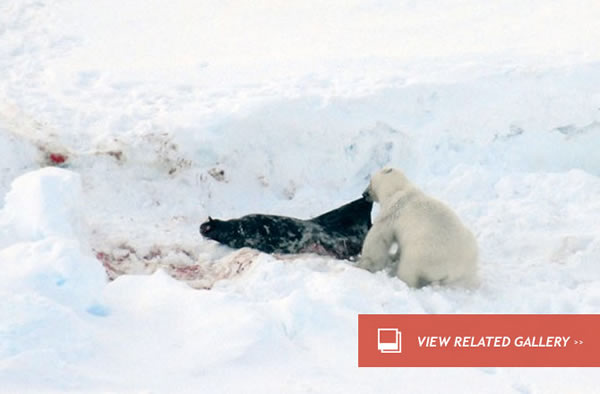Polar Bears Dining on Strange, Toxic Seals
Polar Bears Dining on Strange, Toxic Seals
Polar bears in eastern Greenland have taken to dining on the unhealthy table scraps of climate change. Melting Arctic sea ice has depleted the population of ringed seals that once formed the main course of the bears’ buffet. As the bears switched to harp and hooded seals, the predators received a side order of pollution.
“The problem is that the sub-Arctic seals the polar bear has switched to have a higher content of contaminants because they live closer to the industrialized world and are higher up in the food chain,” said Rune Dietz of Aarhus University in a press release.
Polar bears, like orcas and humans in the Arctic, collect high levels of pollutants because these top predators acquire all the toxins that their prey (and their prey’s prey) built-up over the years.
The polar bears harbored chemicals like the pesticide DDT, polychlorinated biphenyls (PCBs), and other materials, known as persistent organic pollutants (POPs), according to research by Dietz and an international team of environmental scientists. Although regulation in the industrialized world limits the production and release of these chemicals, the toxins remain in the polar bears’ systems. “We can see that the content of the POPs after year 2000 decreases slower in the polar bear than in the ringed seal,” Dietz added.
Hooded and harp seals contain higher levels of these pollutants and the bears increased their consumption of these seals by 9.5 percent per decade over the past 28 years, wrote Dietz and his team in Global Change Biology. At the same time, their diet of ringed seals dropped by about 14 percent per decade.
Ringed seals, which prefer to live on ice floes, once formed approximately 90 percent of the bears diet in 1984. As the Arctic sea ice has shrunk, the bears are swimming further out to sea and seeking alternative food sources in open waters. In 2011, ringed seals accounted for only 34 percent of the bear’s diets.
To make their determination, Dietz and his team used samples of the bears’ fat tissue collected after Inuit hunters harvested the bears from 1984 to 2011. Ringed seals leave a different signature blend of fatty acids in the bears’ flesh than either hooded or harp seals. By analyzing these differences, the scientists could approximate how much of the bears’ diets consisted of ringed seals compared to hooded and harp seals or other potential prey species. For example, they also found that rarely, if ever, did the polar bears consume bearded seals, narwhals, or walruses.
IMAGE: Polar bear with adult hooded seal. The hooded seal can weigh up to 300-400 kg, so it is a large prey for the approx. 500 kg heavy polar bear. (Rune Dietz, Aarhus University)(Sep 24, 2013 08:38 AM ET // by Tim Wall)












